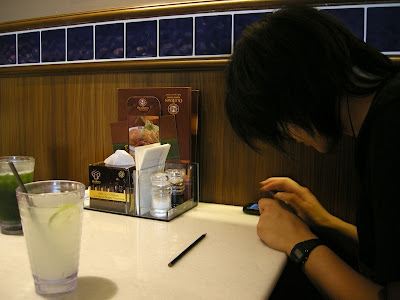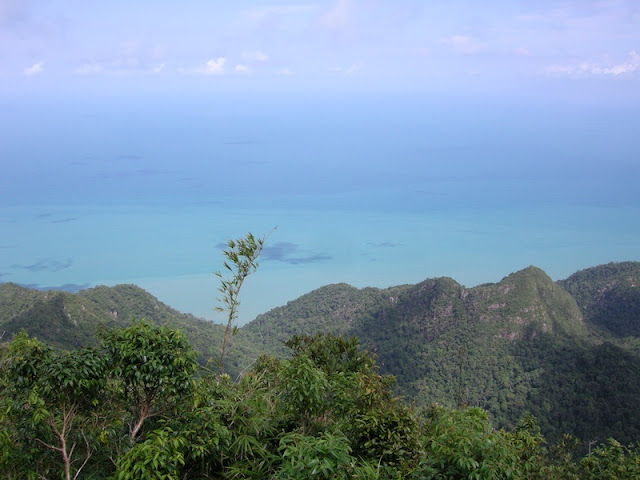Last August, I travelled to Alor Setar and Langkawi with some of the d'NAers. Took the train with Yen to Alor Setar, where we met up with SooT, and then the ferry from Kuala Kedah to Langkawi. Mich and Tien flew from Singapore to Langkawi, meeting us on the island.
Haven't written a blog post like this in a long time—a fun chronicle of a trip, without too much poetry or philosophy.
There is a sheer drop over a killer waterfall at the end, with nothing but a wire barrier in between. So care should always be exercised when sliding between the wells.
That afternoon, we got back and spent the evening chilling with booze on the beach, enjoying the wind and the waves. And then it was dinner at Joe's Tavern, the establishment formerly known as 1812.
The PKV gang and I dropped by in December 2010, when the tavern had just reopened after a season of renovations. That night, Bolton won their EPL match, and the owner, Joe, a lifelong Bolton fan, served up a round of butterscotch shots for everyone.
I took some photos at that visit, and was very happy to pass them on to Joe. The night after the Chong Wei-Lin Dan match, I popped over to Joe's and surprised him with the photos. He was clearly delighted and said it made his day; it certainly made mine.

He then brought us to visit the USSR Restaurant on Pantai Tengah, run by a Soviet Russian called Timur. We were rather full after dinner and so only had drinks (plus a cold soup dish), but I should very much like to visit again to try the food.
Took some portraits with the Fuji on its maiden trip.


We had brunch on our last day at this new establishment called The English Tea Room, directly across the road from the Underwater World. It is run by Annette, a Derbyshire woman. A most delightful person and place—with killer piped-in music, if oldies (Bee Gees!) is your thing.
I brought the Fuji GW690II medium format rangefinder along—a bulky camera by SLR standards, but lightweight for medium format.
With a 6x9-cm negative size, it only allows an extremely conservative eight frames per roll. Great for portraits, still lifes and some landscapes, but not so much for travel. Still, I wanted to try it out and put the quality of medium format to the test.
For these comparisons, I pit the Fuji (loaded with Kodak Ektar 100) against my Nikon P5000 compact camera.

Umbrellas and tables at the Yellow Café on Pantai Cenang at sunset. This is digital, and what the scene really looked like.
Umbrellas and tables at the Yellow Café, really really yellow on medium format.
The white balance setting on digital cameras either warms or cools everything; only in film can a warm colour (e.g., yellow) be warmed and a cool colour (e.g., blue) be cooled, simultaneously.


Leaves, green and extra orange, with the blue somewhat washed out but the yellow glow of morning sun far more palpable.

Black-and-white has an immortal presence in the art world, yet none of us sees the world in black-and-white. Photography has always been about capturing an emotion, expressing an idea or a feeling.
But still, in spite of all this, the best camera is the one you have with you—in the words of Chase Jarvis.
Perhaps film would've looked even grander, but I could run faster with my compact P5000, and being there to catch the moment was the most important thing. So while Joe's fish and chips were frying on the griddle, there I was on the land's edge, soaking in our second, and last, Langkawi sunset.
I have heard it said, "If it's worth shooting, it's worth shooting on film."
But I love digital compacts for their stealth and ease-of-use; they're light and fun to bring around. Digital is great for candids because you never know which shot will be 'the one', but then life is not all comprised of candid moments, hence the argument for film. Plus, a manual film camera doesn’t die on you, but digital chargers and spare batteries can be a bother.
Ultimately I love film for the simplicity of workflow, and how it allows you to concentrate on enjoying the moment and not being preoccupied with the results. And in the end, the 'limit' of available frames (36 per roll of 35mm film vs the hundreds afforded by a memory card) is a good thing: who needs so many shots anyway?
Haven't written a blog post like this in a long time—a fun chronicle of a trip, without too much poetry or philosophy.
* * *
The girls and their drinks, Old Town at this new mall along the Cenang stretch, somewhere across and down the road from the Underwater World. I can't remember the name of the mall, but it could well be Cenang Mall.
SooT and the rise of a rather disturbing table habit.
After lunch we headed to Pantai Tanjung Rhu for the afternoon, in an attempt to catch what is said to be one of the most beautiful sunsets on the island.
Yen sinking into the sand, Pantai Tanjung Rhu.
Ben, water and kayak on Pulau Rawa, off Mersing.
(Photographed in 2007 by Tien, whose shadow is also visible.)
That evening was the Olympic badminton final between Lee Chong Wei and Lin Dan.
Lee Chong Wei on TV.
The audience at a mamak on Pantai Cenang.
d'NAers watching over dinner at the Chinese restaurant next to the mamak. The chef at the restaurant was a China national, and the atmosphere in the kitchen seemed a bit more heated than usual!
The next day, we rode the cable car up to views of where the ocean and sky blurred into a gentle wash of blue.
And then SooT and I hiked up to the Telaga Tujuh (Seven Wells—a series of seven rock pools) while the girls hung around at the Oriental Village.
Lotong (Silvered Langur) with child, on the road to the start of the trail.
Where one of two streams flows out into the wells.
View over the wells and the sea beyond.
That afternoon, we got back and spent the evening chilling with booze on the beach, enjoying the wind and the waves. And then it was dinner at Joe's Tavern, the establishment formerly known as 1812.
The PKV gang and I dropped by in December 2010, when the tavern had just reopened after a season of renovations. That night, Bolton won their EPL match, and the owner, Joe, a lifelong Bolton fan, served up a round of butterscotch shots for everyone.
I took some photos at that visit, and was very happy to pass them on to Joe. The night after the Chong Wei-Lin Dan match, I popped over to Joe's and surprised him with the photos. He was clearly delighted and said it made his day; it certainly made mine.

Joe, with the d'NAers.
SooT at the USSR Restaurant.
Took some portraits with the Fuji on its maiden trip.

Joe at his tavern.
SooT, climbing a tree.

Annette (in purple) at The English Tea Room.
* * *
I brought the Fuji GW690II medium format rangefinder along—a bulky camera by SLR standards, but lightweight for medium format.
With a 6x9-cm negative size, it only allows an extremely conservative eight frames per roll. Great for portraits, still lifes and some landscapes, but not so much for travel. Still, I wanted to try it out and put the quality of medium format to the test.
For these comparisons, I pit the Fuji (loaded with Kodak Ektar 100) against my Nikon P5000 compact camera.

Umbrellas and tables at the Yellow Café on Pantai Cenang at sunset. This is digital, and what the scene really looked like.
Umbrellas and tables at the Yellow Café, really really yellow on medium format.
The white balance setting on digital cameras either warms or cools everything; only in film can a warm colour (e.g., yellow) be warmed and a cool colour (e.g., blue) be cooled, simultaneously.

Sunset on Pantai Cenang as we saw it, digital orange against fading grey sky.

Sunset on Pantai Cenang as we felt it, magenta-yellow-orange on purple sea and cobalt sky.
Leaves, green and orange against a blue sky.
Leaves, green and extra orange, with the blue somewhat washed out but the yellow glow of morning sun far more palpable.

Deck chair on a cloudy morning, colours as seen and remembered. (The haze is due to vapour on the lens—my fault.)
Deck chair again, colours crazy-fied by Kodak Ektar: deep yellow chair on grey sand, and pastel blue sky on turquoise sea.
Some might argue that this is 'unnatural', but since when has photography been about producing exact facsimiles of what we see?
Black-and-white has an immortal presence in the art world, yet none of us sees the world in black-and-white. Photography has always been about capturing an emotion, expressing an idea or a feeling.
But still, in spite of all this, the best camera is the one you have with you—in the words of Chase Jarvis.
Pink clouds in sunset sky, the evening at Joe's.
Waves upon the sand.
* * *
I have heard it said, "If it's worth shooting, it's worth shooting on film."
But I love digital compacts for their stealth and ease-of-use; they're light and fun to bring around. Digital is great for candids because you never know which shot will be 'the one', but then life is not all comprised of candid moments, hence the argument for film. Plus, a manual film camera doesn’t die on you, but digital chargers and spare batteries can be a bother.
Ultimately I love film for the simplicity of workflow, and how it allows you to concentrate on enjoying the moment and not being preoccupied with the results. And in the end, the 'limit' of available frames (36 per roll of 35mm film vs the hundreds afforded by a memory card) is a good thing: who needs so many shots anyway?






















